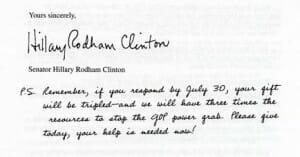Every Tuesday this season, I’m offering a tip on how to write better fundraising appeals. The first post was Call Me By Name.
 Besides getting the donor’s name right, what’s the easiest thing you can do to increase the chance they will give?
Besides getting the donor’s name right, what’s the easiest thing you can do to increase the chance they will give?
Answer: write a good postscript.
The P.S. Matters as Much as the Letter
The National Mail Order Association says:
79% of all people who open your direct mail will read the P.S. first. Before reading anything else in the letter. Or any other part of the mail package.
And in fact, if you don’t catch the donor’s eye with your salutation, your postscript, and your photos, you might as well not send the letter at all. Into the recycling it goes.
This may seem harsh. It does to me. I’m a writer by nature, practice, and inclination. Looking for the right word feels something like meditation, where I let meaning float to the surface….and something like a wine tasting, where I savor each word on the tongue. How can my writing not matter to the reader?
The simple truth is that nothing we write matters if no one reads it. And the postscript is one of the most important tools we have for getting the donor to read the letter.
What to Put in a Postscript
Because the P.S. is the first (and sometimes the only) part of a letter that readers read, it is not a throwaway line. In fact, you should use it to make your main point clear.
One of my favorite approaches is to summarize the appeal in a few short words and then call for action.
Look at the example from the Clinton campaign above. “Stop the GOP power grab” was the theme of the letter, and here it is again, baldly stated, in a few words. “Respond by July 30” tells the reader what action he or she can take.
Other experts, like the late Ray Jutkins, say to emphasize “the special something they will get when they respond.” That might be the premium you are offering them for giving, or (as in the Clinton letter) the chance to see their donation matched. For a nonprofit, it can be a cogent statement of the difference their donation will make.
What’s more, the P.S. can be used to repeat your telephone and fax numbers, physical address, e-mail and Web site. It’s almost impossible to restate your vital contact data too often, Jutkins says.

